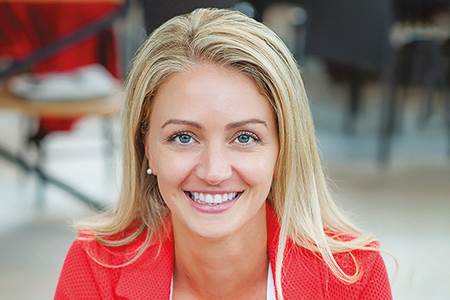“We somehow, perhaps by instinct, decided to side with the environment”

Head of marketing and R&D, Alice Tonello also leads the family-owned company’s Research Centre and Creative Area that are its innovation and experimentation hubs. Her vision and commitment have been instrumental in shaping the laundry machinery maker’s reputation for advanced and sustainable solutions.
Telling your own story is never easy. It is even more difficult to summarise the evolution of a 40-year-old company where you have lived and worked for years. It is like trying to take a snapshot from a moving train – the landscape is blurred, details are out of focus. It is possible, however, to capture a broad vision where distinctive features can be seen and make sense. In my case, what I see as standing out clearly over the years is called sustainability. I use this word consciously, despite it having become a catchword that is used and abused by everyone. I use this term because it is ingrained in our essence since the very beginnings of our company. When there was, that is, no talk of it at all.
In 1981, we did not know it yet, but we were born sustainable. Back then, everything had yet to be invented, we did not even know we had a ‘vision’, we just proceeded like most everyone else does, from day to day, working like crazy, driven by an unwavering passion to ensure the company’s growth, and powered by the wild expansion of the denim market.
In the midst of this near chaotic spirit of experimentation and research, which was heedless of its effects and potential damage, when no one was aware of the need to think of future generations, we somehow, perhaps by instinct, had already decided to side with the environment. Right from the start, the machines we designed had a strong focus on efficiency, that is avoiding wasting energy, water, chemicals, and resources in general. The world of denim was decidedly ‘dirty’ at the time, and we were already striving to simultaneously ensure the growth of the company, the economic well-being of our employees and their families, and a completely unconscious attempt to lessen what would one day be called a carbon footprint.
Our aim, even back then, was not simply to produce and sell the best garment finishing machines on the market, we also sought to improve them and make production processes more efficient, to reduce costs for the customer and turn an expenditure into a long-term investment.
This is basically what we continue to do today, guided by a vision for our own business, which is to reinvent the laundry and its processes, to give people back their value; and our dedication to our customers’ needs: improving their operations, inspiring brands, and making the laundry environment conducive to experimentation and research, a laboratory of ideas to imagine and design a sustainable, healthy, efficient future.
We have never considered ourselves to be just manufacturers of machines, but rather of ideas and solutions that help all realities become more virtuous, through constant incremental improvement. Our technologies and accessories can be applied to existing older machines. They are designed to contain energy waste and process residues, the use of hazardous chemicals, the spread of dust in the work environment, and the need for manual operations by staff. Without false modesty, I would say that we were pioneers in responsibility.
Today we continue to tread the same path with an ever more conscious determination. This can be seen in our ‘ideal laundry’ embodied by what we call the Laundry (R)evolution – simple, digital, responsible. I would add that it is also beautiful, as we pay attention to sustainability as much as to aesthetics. All our technologies are designed to work together in a single machine, even if it is not the latest generation. This is our All-in-One System that simplifies and automates processes, making the laundry a cleaner, safer, more creative, responsible and attractive environment, also for the young generations. It is an environment that makes it possible to create garments in an ever more responsible manner.
It is also, I would add, transparent. The entire process is monitored and controlled by Metro, our software that tracks the consumption of electricity, water and steam, etc., and can objectively measure the level of sustainability of each garment. Metro issues an environmental passport based on all the production stages of a garment. It is a real ‘report card’ based, this is important, on data that is automatically collected and cannot be altered.
Personally, I am convinced that the world of jeans will evolve towards greater traceability of processes and garments. This will be ultimately useful for the consumer, or rather the citizen, who is increasingly aware of and attentive to these issues. When purchasing a pair of jeans, he or she will no longer focus only on price and style, but also on sustainability. That is what I would call the added value of truly authentic ‘great beauty’.













